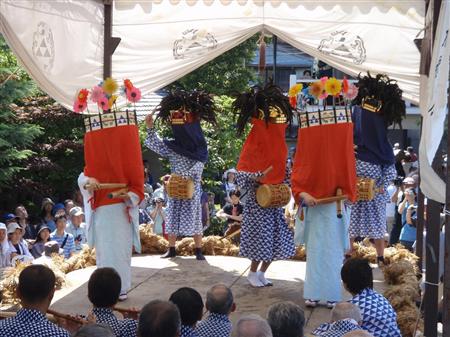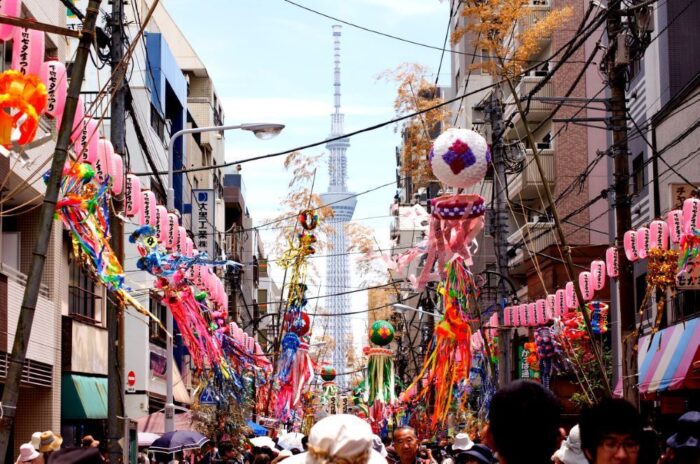Mizudome-no-mai, a 700-year-old rain-stopping dance tradition in Tokyo, continues to captivate locals and travelers alike with its cultural and historical significance.
This mesmerizing dance, held at Gonshoji Temple on July 10th, is believed to possess the power to halt rain.

Rooted in the ancient Japanese tradition, participants blow conch shells and don lion masks, creating a spiritual atmosphere.
Mizudome-no-mai not only adds cultural richness to the Shinjuku Eisa Festival but also serves as a testament to the preservation of ancient traditions and the promotion of cultural awareness in Tokyo.
Key Takeaways
- Mizudome-no-mai is a traditional spiritual event in Tokyo that has been around for about 680 years.
- The dance is believed to have the power to stop the rain and takes place at Gonshoji Temple on July 10th.
- The tradition originated in 1321 during a drought and is dedicated to the dragon god, marking the beginning of summer.
- Mizudome-no-mai showcases Japanese tradition, adds cultural richness to the Shinjuku Eisa Festival, and highlights Omori’s cultural history and its relationship with nature.
Mizudome-no-mai Tradition
The Mizudome-no-mai tradition, which has been celebrated for over 680 years, is believed to possess the power to stop rain and takes place at Gonshoji Temple on July 10th.
This ancient tradition holds a rich historical background and is deeply rooted in Japanese culture.
The ritualistic elements of Mizudome-no-mai are what make it truly captivating. Participants blow conch shells, symbolizing the call for the dragon god’s presence. They also wear lion masks, representing the power and authority needed to control the rain.
The tradition originated in 1321 during a severe drought, when the people of Tokyo prayed for rain. Since then, it has become an integral part of the local community, offering a sense of hope and connection to the forces of nature.
The Mizudome-no-mai tradition continues to enchant spectators with its vibrant dances and profound spiritual significance.
Significance and Origin
Originating in 1321 during a severe drought, this traditional event marks the beginning of summer and is dedicated to the dragon god. Mizudome-no-mai holds deep cultural symbolism and is a reflection of the ancient practice of dragon god worship.
The significance of this event lies in its ability to bring rain and prosperity to the community. Participants blow conch shells, don lion masks, and perform a mesmerizing dance that embodies the power and spirit of the dragon god.
The origin of Mizudome-no-mai stems from the belief that by paying homage to the dragon god, individuals can invoke its blessings and ensure an abundant harvest. This age-old tradition not only showcases the rich cultural heritage of Tokyo but also serves as a reminder of the deep connection between humans and nature.
Venue and Accessibility
Located in the Omori area of Tokyo, Gonshoji Temple is the venue for the traditional Mizudome-no-mai event. It can be easily accessed with a 10-minute walk from Omorimachi station.
The temple, originally built as Kaiganji Temple in 1272, holds a deep historical significance in the area. Omori has a strong connection with the seaweed fishing culture, and Gonshoji Temple played a vital role in supporting the livelihoods of local fishermen. The temple provided spiritual guidance and protection for those venturing out to sea.
Today, the temple stands as a testament to the rich cultural heritage of the area. It serves as a gathering place for the Mizudome-no-mai tradition. Visitors can explore the temple grounds, admire the beautiful architecture, and immerse themselves in the vibrant atmosphere of this ancient rain-stopping dance.
Michi-Yuki Ceremony
During the Michi-Yuki Ceremony, participants engage in a traditional procession, playing with conch shells and carrying straw dragons as they ask for rainfall. This ancient ritual holds a deep spiritual significance in Japanese culture.
The procession is a way for people to connect with the elements of nature and seek blessings from the water gods. As the participants move gracefully through the streets, the sound of the conch shells fills the air, creating a sense of reverence and anticipation.
The straw dragons, symbolizing the water gods, are carried with great care and devotion. This procession not only honors the traditions of the past but also reminds us of the interconnectedness between humans and nature.
It is a beautiful and meaningful ceremony that showcases the rich cultural heritage of Tokyo.
Cultural Preservation and Impact
Preserving the ancient traditions of the Michi-Yuki Ceremony and showcasing the rich cultural heritage of Tokyo, Mizudome-no-mai adds a sense of reverence and anticipation to the Shinjuku Eisa Festival.
This timeless rain-stopping dance holds immense cultural significance and plays a vital role in the promotion of Tokyo’s cultural heritage.
Mizudome-no-mai offers a unique opportunity for locals and tourists alike to witness a hidden side of Tokyo and immerse themselves in its traditional customs.
The dance not only highlights the historical significance of the tradition but also serves as a reminder of the deep connection between Omori’s cultural history and its relationship with nature.
Frequently Asked Questions
How did the tradition of Mizudome-no-mai evolve over time?
Over time, Mizudome-no-mai has evolved by adapting to modern times while maintaining its cultural significance. It has played a crucial role in preserving Tokyo’s cultural identity and promoting tourism, enhancing the city’s reputation.
Are there any specific rituals or prayers performed during the dance?
During Mizudome-no-mai, dancers perform specific steps while offering prayers and various items like rice, fruit, and sake. These rituals symbolize gratitude, purification, and a request for rain to stop, adding to the dance’s significance and spiritual nature.
What is the role of the lion masks worn by the participants?
The lion masks worn by participants in Mizudome-no-mai hold symbolic significance. They represent the power and ferocity of the dragon god, adding to the cultural significance of the tradition and creating a visually captivating experience.
How has Mizudome-no-mai been influenced by modernization and urban development in Tokyo?
Modernization and urban development in Tokyo have impacted Mizudome-no-mai by increasing its accessibility and exposure. This has had a positive impact on the preservation of the tradition, as more people are able to experience and appreciate its cultural significance.
Are there any other similar rain-stopping traditions in different parts of Japan?
Different rain-stopping traditions in Japan include “Ame-no-Uzume-no-Mikoto” in Izumo and “Hoshi Matsuri” in Kyoto. These rituals hold cultural significance as they demonstrate the Japanese belief in the power of spiritual practices to control the weather.
Conclusion
In conclusion, Mizudome-no-mai is not just a dance, but a mesmerizing tradition that brings together history, culture, and spirituality.
This 700-year-old rain-stopping dance is a unique experience that allows locals and travelers to witness the hidden side of Tokyo and appreciate its rich cultural heritage.
With its origins dating back to a drought in 1321, Mizudome-no-mai not only showcases Japanese tradition but also plays a crucial role in preserving ancient customs and promoting cultural awareness.
So next time you find yourself in Tokyo, make sure to witness this timeless dance and be a part of history.



